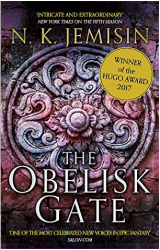I’ll admit that reading The Fifth Season had a bit of a learning curve for
the Broken Earth series. Not only did I have to learn about the vastly
powerful magic system based on rocks (and other rock forms), but I had to get
used to a second-person point of view (POV). Jumping between timelines with
similar characters who had different names was a bit confusing, but I was
able to figure it out by the end. Fast forward to the sequel, The Obelisk
Gate, and most of my qualms with the first book were smoothed over or solved
outright.
One of the things I enjoyed about The Obelisk Gate was the increase in the
scale of the magic system. Including the moon in these calculations makes
perfect sense considering the nature of the orogeny magic. I also appreciated
how the story seemed to focus on a single POV, which made for a more intimate
experience as we followed only one or two individuals instead of four. Now
that I was used to the second-person writing style and the character it
described, it didn’t bother me as much as when I read The Fifth Season.
While The Fifth Season set up the world-building for this trilogy, The
Obelisk Gate’s only weakness is that it finally set up the climactic plot
for the third book. Sure, there was plenty of character development and
intriguing twists in the plot in The Obelisk Gate, but they all seemed to be
hinting at something much more significant that wouldn’t take place in this
book. I do appreciate an excellent three-act structure, so this slight
weakness can be seen as merely an artifact of the second book in a trilogy.
In fact, because it was more focused, I liked this book more than its
predecessor. After all, it’s a strong concept with solid execution.
A focusing and foreshadowing of the Broken Earth series, I give The Obelisk
Gate 4.5 stars out of 5.
